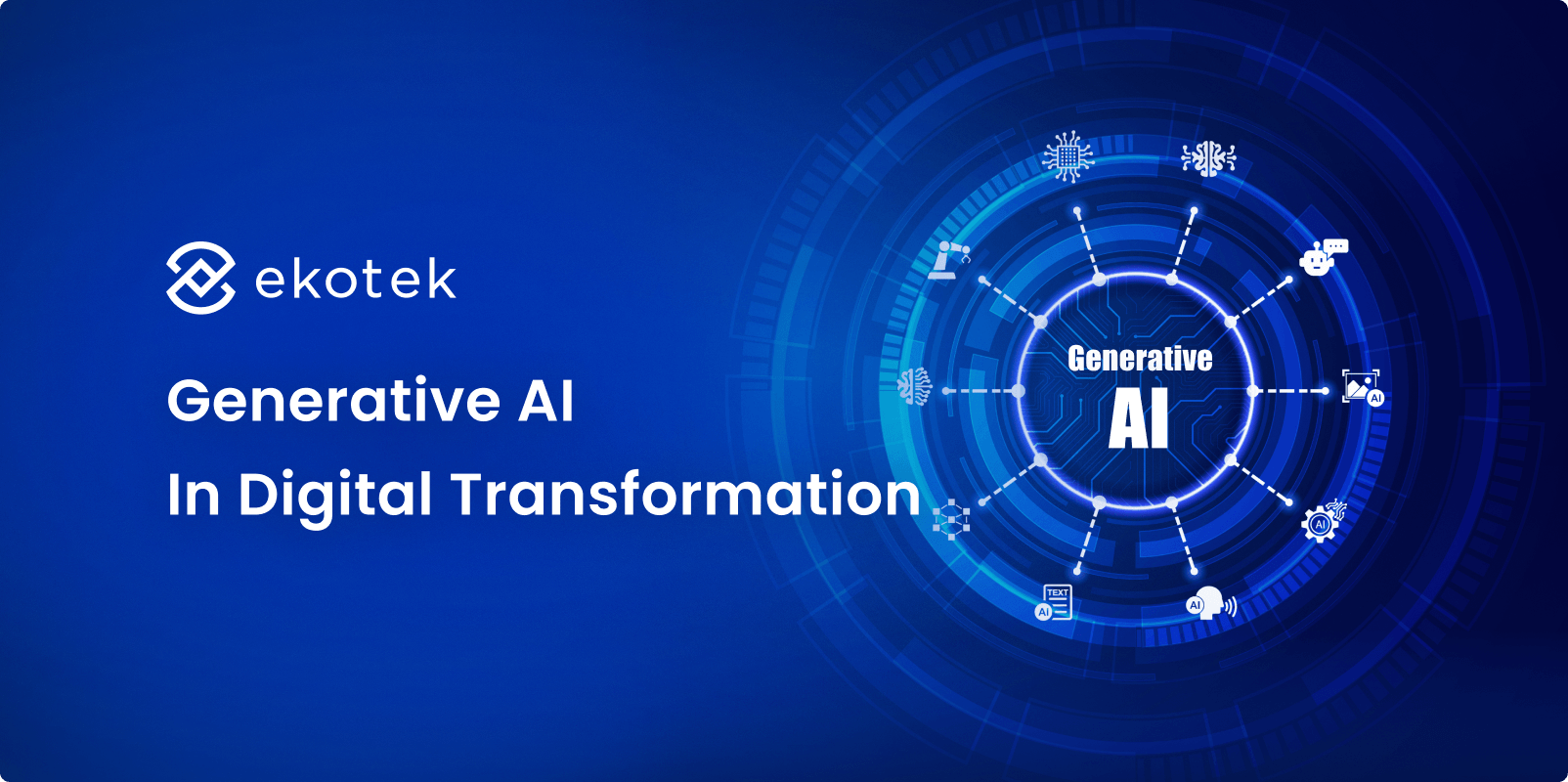
- 1
- 2
- 3
- 4
- 5
- 6
- 7
- 8
- 9
Introduction
Across industries, enterprises are under pressure to innovate faster, serve customers better, and make smarter decisions, especially as they initiate enterprise generative AI adoption amid outdated systems, siloed data, and growing operational complexity. According to McKinsey, generative AI could contribute up to $4.4 trillion annually to global business value, particularly when embedded into customer operations, marketing, software development, and R&D. In this post, we explore how generative AI is transforming business digital transformation, key benefits, use cases, challenges, and actionable steps to implement it successfully.
Traditional AI vs. Generative AI in digital transformation
Traditional AI in digital transformation
Traditional AI, often referred to as narrow AI, is primarily designed for discriminative tasks, such as classification, regression, clustering, and anomaly detection. These systems are built using supervised or unsupervised machine learning algorithms, trained on structured datasets to identify patterns and make predictions.
Use cases include fraud detection in banking, churn prediction in telecom, or demand forecasting in supply chains. Technologies like decision trees, support vector machines (SVM), and gradient boosting models are commonly used, along with traditional rule-based systems for deterministic outcomes.
What is generative AI?
Generative AI, on the other hand, is a subset of deep learning that focuses on generative tasks, creating new data that resembles the training data. It relies on advanced architectures such as transformers, Generative Adversarial Networks (GANs), and variational autoencoders (VAEs). Popular models like GPT (text), DALL·E (image), Codex (code), and Gemini (multimodal) are trained on massive corpora of unstructured data to understand context, semantics, and intent, allowing them to generate entirely new outputs.
Generative AI doesn’t just recognize patterns, it produces novel content such as:
- Business reports, policy documents, emails
- Product images or marketing creatives
- Software code snippets or entire modules
- Synthetic datasets or business simulations
These models are generally trained using unsupervised or self-supervised learning, enabling them to scale across domains and adapt to a wider variety of tasks with minimal fine-tuning.
| Aspect | Traditional AI | Generative AI |
|---|---|---|
| Primary function | Analyze, classify, predict | Generate new content or data |
| Typical use cases | Fraud detection, churn prediction, demand forecasting | Text generation, image creation, code generation |
| Output type | Structured decisions or classifications | Creative, open-ended outputs |
| Data requirement | Labeled, structured data | Large-scale, unstructured data |
| Learning type | Supervised / Unsupervised Learning | Unsupervised / Self-supervised Learning |
| Tech stack | Decision Trees, SVM, XGBoost, Rules-based | Transformers, GANs, VAEs (GPT, DALL·E) |
| Creativity | None | High |
| Interpretability | Higher (in simpler models) | Lower (often black-box models) |
| Infrastructure demand | Moderate | High (GPU/TPU, large-scale compute) |
| Risk level | Lower (more controlled) | Higher (bias, hallucination, misuse) |
| Role in digital transformation | Optimizes existing processes | Reimagines and creates new possibilities |
📌 Read more about The benefits of AI Chatbots using ChatGPT
Why generative AI matters in digital transformation?
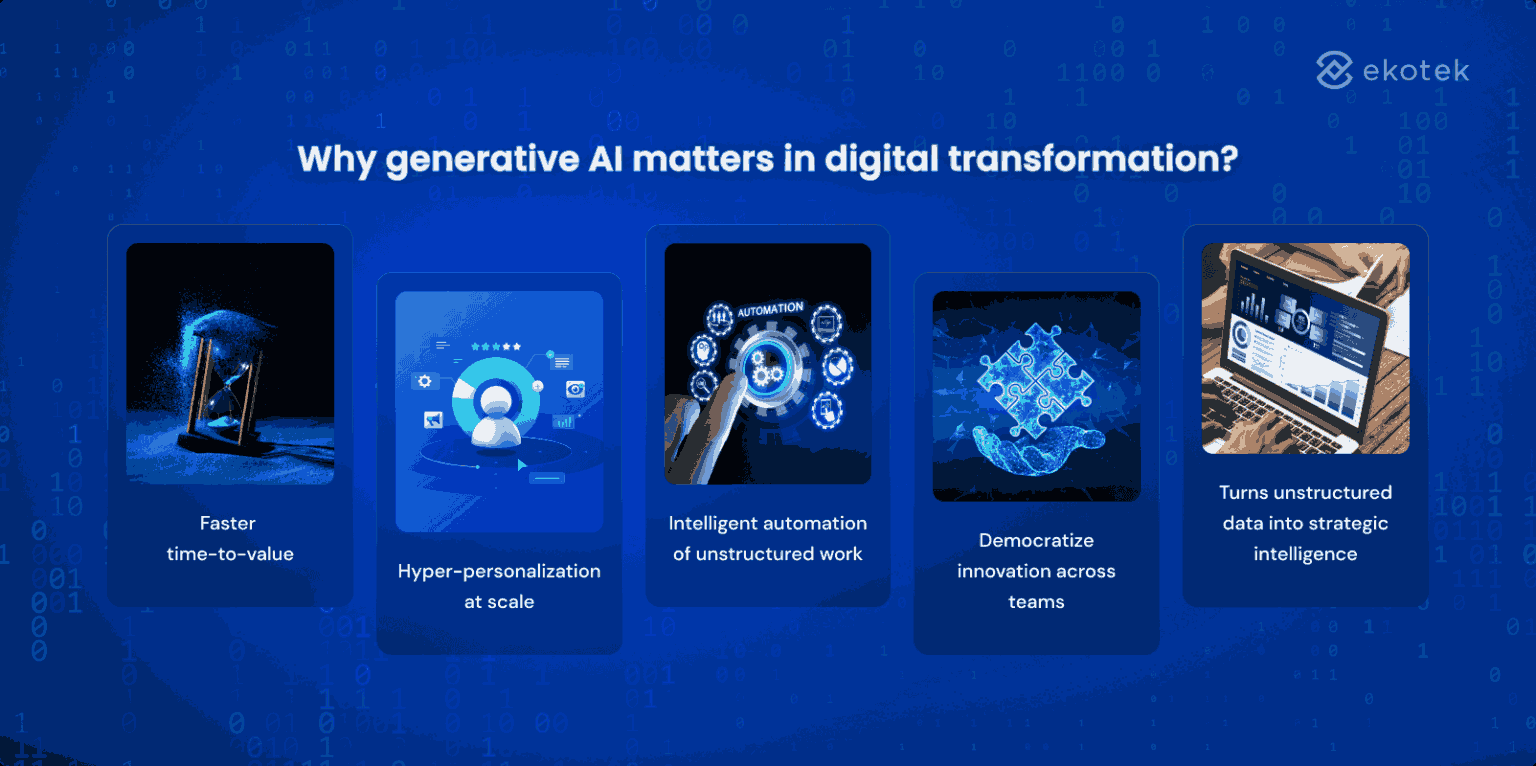
Faster time-to-value with generative AI
Traditional transformation efforts often suffer from long development cycles, delayed value realization, and resource bottlenecks.
Generative AI collapses the distance between ideation and execution. It can instantly generate draft marketing campaigns, business reports, legal contracts, software modules, and even analytics dashboards. This means faster experimentation, quicker pivots, and dramatically shorter delivery timelines.
Hyper-personalization at scale in digital transformation
Personalization at scale is extremely hard, often limited by content production capacity or data silos.
By leveraging customer data and real-time input, Generative AI can dynamically generate tailored content, product recommendations, onboarding flows, and support responses. Unlike static automation tools, it adapts to changing user behavior and market conditions.
For example: A global retail brand uses GenAI to auto-generate product descriptions and marketing messages for 50+ regions and languages, tailored to local preferences and shopping trends, something previously unmanageable with manual teams.
Intelligent automation of unstructured work using generative AI
Most rule-based automation tools (e.g., RPA) struggle with unstructured inputs and language. Generative AI models like GPT can understand natural language, context, and tone, making them ideal for tasks like customer service, employee support, and content generation.
Democratize innovation across enterprise teams with generative AI
Innovation is often siloed in R&D or IT departments, limiting organization-wide creativity and agility.
Generative AI acts as a cognitive co-pilot for all teams, from HR to product design to legal. It empowers employees to ideate, draft, simulate, and prototype without needing technical expertise. This flattens hierarchies of innovation and accelerates cross-functional collaboration.
Turns unstructured data into strategic intelligence through generative AI
Most enterprise data (emails, PDFs, call transcripts, reports) remains unused because it’s unstructured and time-consuming to process.
Generative AI can extract meaning, summarize trends, and generate actionable insights from massive volumes of unstructured data, fueling smarter decisions, faster compliance reporting, and real-time operational awareness.
Enterprise use cases of generative AI in digital transformation
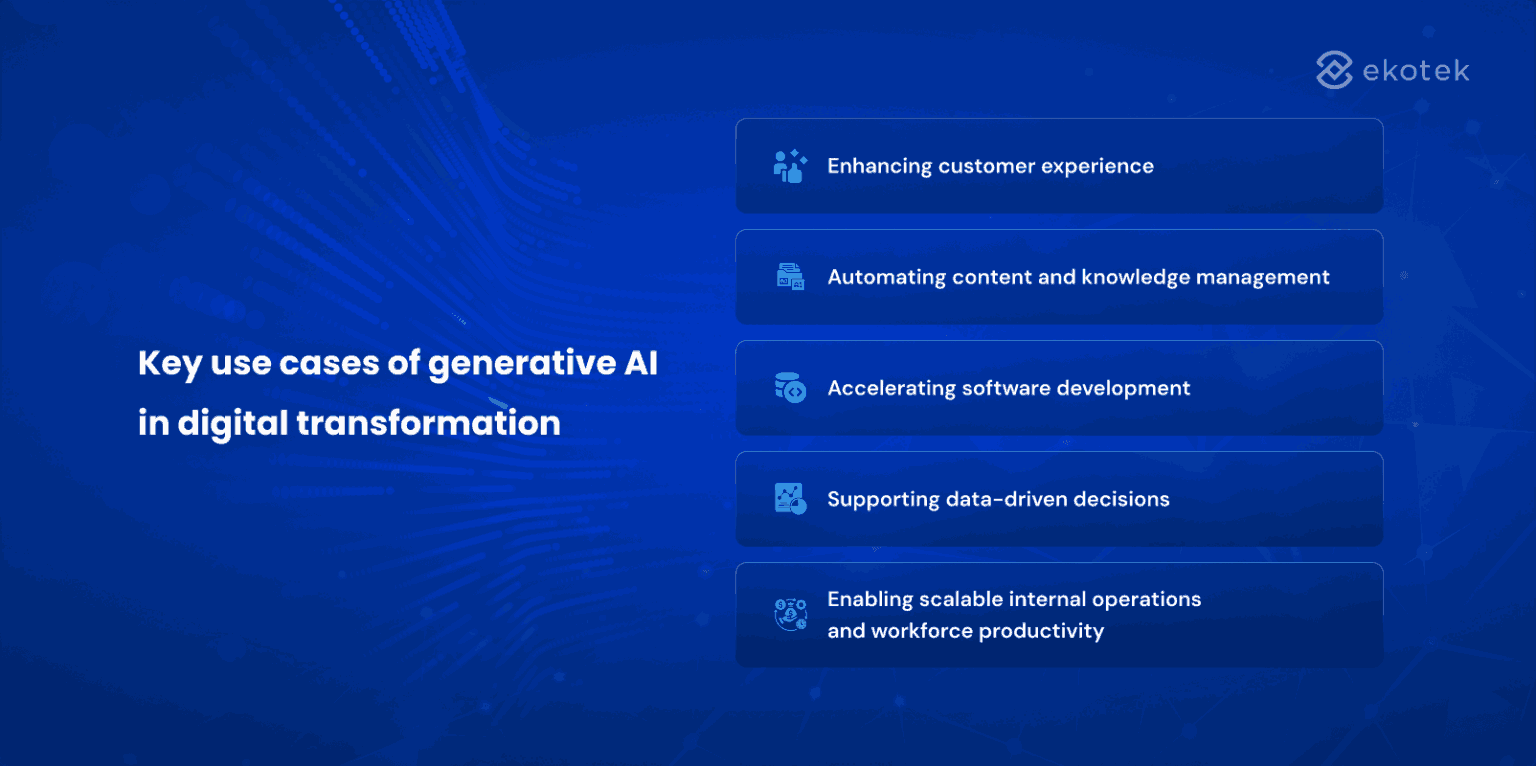
Enhancing customer experience with generative AI
- AI-powered chatbots with human-like intelligence: Traditional chatbots follow rigid decision trees and often frustrate users with robotic or irrelevant replies. GenAI-based chatbots, by contrast, interpret natural language with nuance, understand sentiment, and engage in free-flowing conversations.
- Hyper-personalized content delivery: GenAI enables real-time generation of personalized marketing materials and product recommendations based on past purchases. This allows brands to adapt messaging to individuals, not segments.
- Conversational voice interfaces: Voice-to-text GenAI systems transform spoken input into structured commands or helpful responses. They support everything from troubleshooting to booking, with a natural, human feel.
- Emotion-based feedback analysis: GenAI can ingest and analyze open-text feedback from reviews, chats, and social media. It detects themes, urgency, and emotional tone, helping CX teams prioritize improvements that matter most to customers.
📌 Explore how Ekotek AI chatbot helped an e-commerce company respond to customers case-by-case
Automating content and knowledge management using generative AI
- Smart document generation: Instead of manually drafting policy documents or internal memos, teams can use GenAI to automatically populate templates with relevant data and context, dramatically speeding up documentation processes.
- Training and learning content creation: L&D teams use GenAI to convert complex manuals or onboarding information into engaging training materials, adapted to different formats and roles.
- Enterprise knowledge summarization: Executives and managers are flooded with reports, market analysis, and internal updates. GenAI can summarize long-form content into decision-ready narratives, highlighting key insights and trends.
📌 Ekotek built an AI-powered summarizing tool to help global entrepreneurs access a mountain of news and info in real time
Accelerating software development with generative AI tools
- Natural language to code generation: GenAI allows developers or even non-developers to describe what they need in plain English, and have functional code generated instantly. This democratizes software creation and reduces developer backlog.
- Real-time debugging and code optimization: GenAI models can suggest fixes or flag potential bugs based on the developer’s current context, reducing costly downtime and tech debt.
Supporting data-driven decisions in enterprise digital transformation
- Narrative-based insight generation: Instead of combing through dashboards, business users can receive AI-generated narratives that interpret the numbers. GenAI explains KPIs, trends, and anomalies in clear, business-friendly language.
- What-if scenario simulation: GenAI can create and explain hypothetical business scenarios, helping leaders explore decisions like pricing changes, marketing spend shifts, or supply chain reconfigurations, without needing a data science team on standby.
Enabling scalable internal operations and workforce productivity with generative AI
- AI-powered internal assistants for employee support: Employees in large organizations often waste time searching for information scattered across emails, wikis, and file drives. GenAI-powered virtual assistants can answer questions like “What’s our travel reimbursement policy?” or “How do I set up MFA on my work laptop?” instantly with human-like clarity.
- Knowledge retention and succession planning: When experienced employees retire or move on, their tacit knowledge is often lost. GenAI can help “capture” this know-how by converting years of emails, documents, and notes into searchable knowledge bases or training content.
📌 Download our e-book to have a deep understanding of Generative AI use cases for enterprises
Challenges and risks of using generative AI in digital transformation
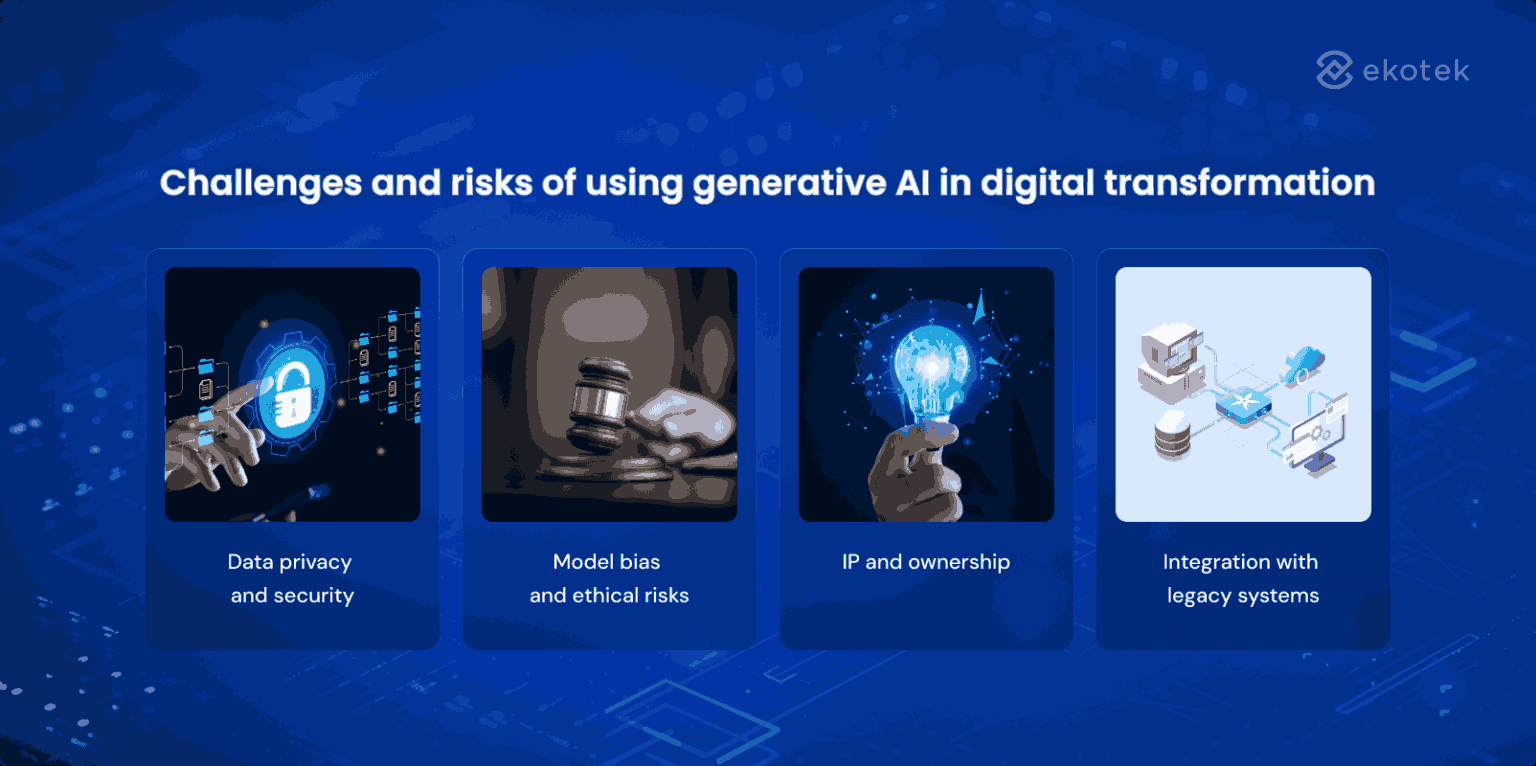
Data privacy and security risks in generative AI
Generative AI systems often need access to large volumes of enterprise data, customer records, employee files, contracts, internal knowledge bases, to deliver value. However, if not handled securely, this can lead to:
- Unauthorized data access: If internal access controls are weak, sensitive information may be exposed during model training or inference.
- Unintentional data leakage: GenAI models can sometimes “memorize” and unintentionally reproduce proprietary data in outputs.
- Regulatory non-compliance: Regulations like GDPR, HIPAA, or China’s PIPL impose strict rules on how data is collected, processed, and stored.
To mitigate this, organizations should deploy GenAI models within secure environments, apply strict access controls, and ensure all training and inference processes follow data minimization principles. Logging, encryption, and regular audits should be standard practice, not optional add-ons.
Model bias and ethical challenges with generative AI
Generative models learn from historical data, which may contain social, racial, gender, or cultural biases. Left unchecked, this can create reputational and ethical fallout.
- Discriminatory outputs: Biased hiring recommendations, skewed financial product suggestions, or exclusionary customer support responses.
- Ethical blind spots: AI-generated decisions may seem objective but often lack nuance or context, especially in sensitive domains (healthcare, law).
- Black box accountability: When AI decisions go wrong, it’s often unclear how or why, creating risk with regulators, customers, and internal stakeholders.
To reduce ethical risks, organizations must implement bias detection processes during model training and testing, use diverse and inclusive datasets, and establish clear human oversight mechanisms. This includes embedding ethics reviews and fairness audits into their model deployment lifecycle, not treating them as one-time checks.
Intellectual property (IP) and ownership issues in generative AI
As GenAI generates content and product descriptions, code, designs and marketing copy-questions of ownership and liability become complex:
- Legal ambiguity: Many jurisdictions have not yet clarified whether AI-generated content can be copyrighted or who holds ownership, creator, user, or platform?
- Brand risk: Using GenAI to produce branded material may result in unintentional replication of competitor content or copyrighted material.
- Inconsistent governance: Without clear IP policies, teams might unknowingly expose the company to legal disputes.
Organizations should establish internal IP policies for AI-generated content, clarify acceptable use cases, and, when dealing with high-value or creative assets, rely on models trained exclusively on owned or licensed data. Legal teams should be consulted early in the AI adoption process to help define responsibility and ownership boundaries.
Integration with legacy systems and generative AI
Many enterprises still operate with fragmented, legacy infrastructure that lacks the flexibility needed for GenAI adoption.
- Disconnected data silos: Without unified data platforms, GenAI tools cannot access or contextualize data effectively.
- API and platform incompatibility: GenAI solutions often depend on modern cloud-native stacks, which legacy systems may not support.
- Scaling limitations: Even successful pilots fail to scale when foundational IT isn’t prepared to support enterprise-wide deployment.
To overcome this, companies must view GenAI adoption as part of a broader modernization effort. This includes investing in cloud infrastructure, API-first architecture, and unified data platforms. Aligning GenAI projects with existing digital transformation roadmaps ensures long-term sustainability and enterprise-wide scalability.
How to implement generative AI in enterprises
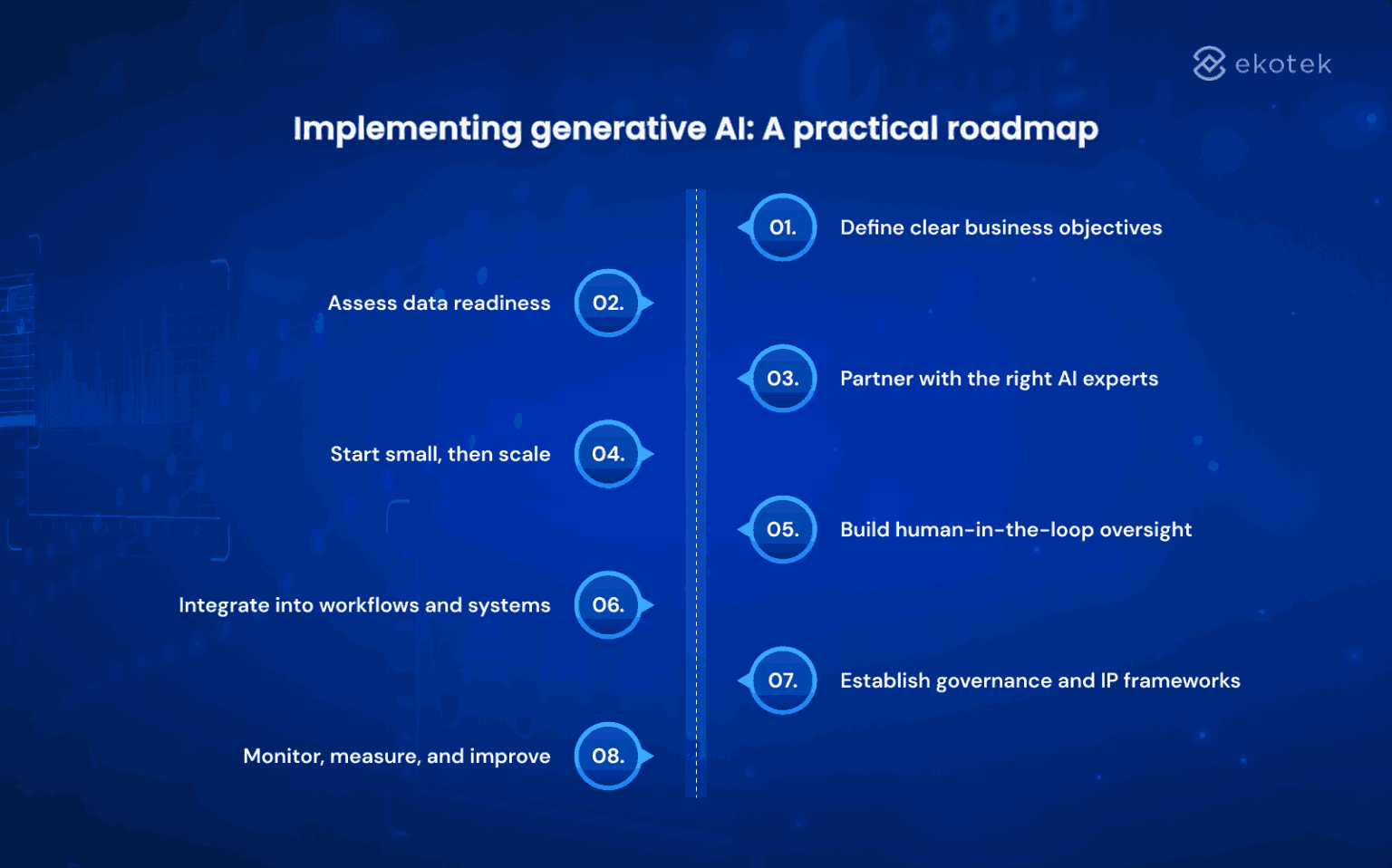
Define clear business objectives for generative AI projects
Start with the problem, not the model. Identify use cases where generative AI can deliver tangible impact, whether it’s improving customer service, automating internal processes, or accelerating product development. Link every AI initiative to a measurable business outcome (reduced support time, increased conversion rate, shorter time-to-market).
Assess enterprise data readiness for generative AI
Generative AI thrives on large volumes of high-quality data, especially unstructured formats like documents, emails, transcripts, and code. Conduct a data audit to identify where relevant data exists, how accessible and clean it is, and what privacy constraints apply.
Partner with the right AI experts for digital transformation
Instead of building everything in-house, many organizations find greater success by outsourcing to experienced AI partners. A qualified partner can fast-track implementation, reduce risk, and provide access to specialized talent and infrastructure, without requiring you to scale internal teams prematurely.
When selecting an external AI provider, go beyond technical capability. Look for a partner who understands your business context, offers end-to-end support (from consulting to deployment), and demonstrates experience in your industry. Strong governance practices, transparent collaboration, and a commitment to ethical AI development should be non-negotiable.
📌 Learn more about: AI Outsourcing – The Complete Guide For Enterprises
Start small with generative AI, then scale
Begin with a pilot project that targets a specific workflow or department. Measure success using predefined KPIs (accuracy, efficiency, satisfaction). Use feedback loops to refine prompts, outputs, and governance policies.
Build human-in-the-loop oversight for generative AI systems
Generative AI is powerful, but imperfect. Introduce checkpoints where human reviewers validate AI outputs, especially in sensitive contexts like customer service, legal documents, or public communication. Combine AI speed with human judgment to reduce risk.
Integrate generative AI into enterprise workflows and systems
AI tools should meet users where they work, not force them to change behavior. Integrate generative AI into your existing tools (CRM, CMS, ERP, HR portals) through APIs, extensions, or custom interfaces. Make the experience seamless and intuitive.
Establish governance and IP frameworks for generative AI adoption
Create policies:
- AI content ownership and attribution
- Acceptable use (no confidential data input in public models)
- Audit trails and logging
- Legal liability for AI-assisted decisions
Collaborate with legal, compliance, and IT teams early in the process.
Monitor, measure, and improve generative AI initiatives
AI deployment is not “set and forget.” Continuously monitor performance, bias, hallucinations, and user adoption. Use this data to improve model outputs, business impact, and user trust over time.
Ekotek’s experience in generative AI projects
One compelling example of how Generative AI can accelerate digital transformation comes from a project delivered by Ekotek in the manufacturing sector.
A leading footwear manufacturer faced a common challenge: the Bill of Materials (BOM) creation process was manual, repetitive, and highly prone to human error. Each product required a custom BOM based on specific design files and production needs, demanding hours of cross-checking and data entry by engineers and planners.
Ekotek developed a custom AI-powered automation solution that uses machine learning models to:
- Analyze design specifications and technical drawings
- Automatically extract relevant material and component data
- Generate accurate BOMs with minimal human input
This solution not only reduced time spent on manual data entry but also improved consistency and collaboration in production teams.
📌 See how our client achieved success with Ekotek’s generative AI solution
Conclusion: The future of generative AI in digital transformation
Generative AI is a key driver of digital transformation today. With its ability to automate content creation, personalize customer experiences, and optimize operations at scale, generative AI is reshaping industries and redefining value creation. However, realizing its full potential requires more than just adopting the latest tools. Success hinges on having a clear strategy, the right infrastructure, and a strong focus on responsible implementation.
That’s where Ekotek comes in. As a trusted AI partner, we offer end-to-end support—from strategic advisory and custom solution development to seamless integration and large-scale deployment. Our flexible services are built around your business goals, combining deep technical expertise with industry know-how to deliver fast, scalable, and impactful AI solutions.
FAQ on generative AI in digital transformation
1. What is generative AI in digital transformation, and how is it different from traditional AI?
Generative AI in digital transformation refers to the use of advanced AI models that can create new content, ideas, or solutions rather than just analyzing existing data. Unlike traditional AI, which focuses on automation and predictive analytics, generative AI enables businesses to design innovative products, simulate customer interactions, and accelerate business process automation. This makes it a game-changer in reimagining digital strategies.
2. How much investment does a business need to adopt generative AI in digital transformation?
The investment required for adopting generative AI in digital transformation depends on the scale of implementation. Costs include infrastructure, AI tools, integration with existing systems, and skilled workforce training. However, many companies see a strong ROI, as generative AI can significantly optimize resources and drive business growth.
3. How can companies ensure ethical and responsible use of generative AI in digital transformation?
To ensure ethical AI adoption, businesses must establish governance frameworks, prioritize transparency, and maintain compliance with data protection regulations. Responsible use of generative AI in digital transformation requires regular audits, bias detection, and human oversight. By adopting clear AI governance policies, companies can build trust while maximizing the benefits of generative AI in digital innovation.
4. Which business functions benefit the most from generative AI in digital transformation?
Generative AI in digital transformation impacts key business functions such as marketing, customer service, product development, and supply chain management. For instance, marketing teams can use AI to generate personalized campaigns, while product teams can accelerate design and prototyping through AI-generated solutions.
- 1
- 2
- 3
- 4
- 5
- 6
- 7
- 8
- 9